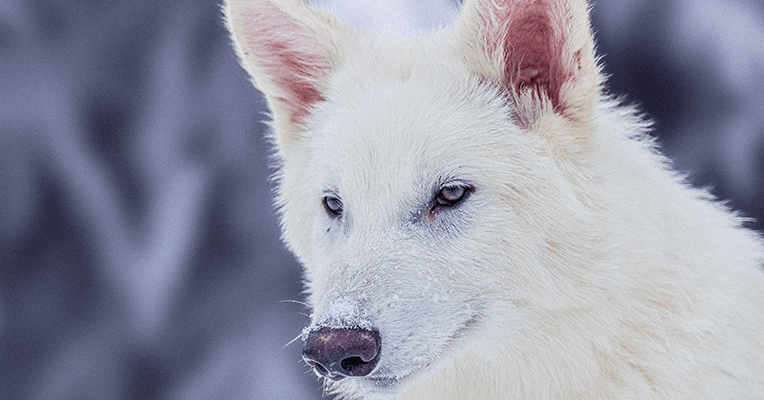
Scientists Claim to Have Revived the Dire Wolf
The startup Colossal Biosciences has modified the DNA of a gray wolf in order to create what they claim is an extinct species animal. However, the question arises: does this make it a true terrifying wolf?
In a secret location in the United States, two white wolves are resting in the grass of an approximately one-acre enclosure under the sun. It is early spring, and a cold breeze blows through the nearby bare trees. The humans in the enclosure are wearing winter coats, while the five-month-old wolves, with their thick and shaggy fur, are better adapted to the low temperatures. Among the visitors is Ben Lamm, founder and CEO of the Dallas-based startup Colossal Biosciences, who has invited a media outlet to be among the first to see the wolves. According to him, they are dire wolves, a species that went extinct over 10,000 years ago and once roamed the Americas, coexisting with other large Ice Age animals such as saber-toothed tigers and woolly mammoths. The company claims this is the first time "de-extinction" of an animal has been achieved.
The wolves, still in their puppy stage, wander the enclosure unaware that they are in a time period that doesn’t match theirs. The series Game of Thrones popularized the dire wolf as the emblem of the noble and tragic Stark House, and now Colossal asserts it has brought back to life— or at least something reminiscent of a dire wolf. Lamm highlights certain characteristics that distinguish these animals from modern wolves: they have more pronounced shoulders, slightly wider heads, and thicker hips than current gray wolves. At five months, they already weigh 80 pounds and are expected to grow larger than their modern relatives. Additionally, they are white, which evokes the character Jon Snow.
Lamm, a serial entrepreneur, co-founded Colossal in 2021 with the intention of bringing back the woolly mammoth, the dodo, and other extinct animals. However, the company is not directly cloning preserved DNA from prehistoric animals, as seen in Jurassic Park. Instead, it edits the genes of current relatives to resemble their extinct ancestors. Lamm explains: "We can not only identify ancient genes and predict their functions, but we can also incorporate them into cell lines, create these traits healthily, and bring them back, which is incredible."
So far, Colossal has created three dire wolves and plans to make a total of seven or eight. The wolves that were shown, Romulus and Remus, were born in October and named after the brothers from Roman mythology who were nurtured by a she-wolf. A third dire wolf, Khaleesi, was born in January. Beth Shapiro, Colossal’s chief science officer, was in the UK during the birth of the first litter and was surprised to hear the news of their arrival. Although the company refers to Romulus and Remus as being from the same litter, this is not entirely accurate, as they are genetically identical but were born to different mothers.
Shapiro comments on the significance of this de-extinction project, suggesting it can provide a new perspective on the biodiversity crisis by allowing people to see a species that we drove to extinction and that has now been brought back. Her work on dire wolves began with research to reconstruct their evolutionary history from fossils.
Colossal has focused on sequencing the ancient DNA from two dire wolf fossils and has redesigned the genome of gray wolf cells, the closest living relative to the dire wolf, making 20 modifications to 14 genes. However, this raises a dilemma about the identity of the wolves: are they truly dire wolves or genetically edited gray wolves? Lamm insists they are dire wolves, while the discussion on how to define a species continues.
A professor at Harvard University, who is a co-founder of Colossal, notes that the goal is eventually to produce an animal with the entire genome of the extinct dire wolf. For now, the focus is on the characteristics that truly define the species. Another conservation expert highlights that there is some subjectivity in defining species and that an animal's ecological role can be as important as its genetics.
To create these wolves, Colossal began with blood from a gray wolf and proceeded to edit the stem cells to resemble the genome of the dire wolf. This process culminated in the implantation of embryos into female dogs as surrogate mothers. The result has been the creation of these two dire wolves and Khaleesi, although they have also faced challenges in the process with some losses.
In addition to working on the dire wolves, Colossal has used its new cloning technique to produce four red wolves, a critically endangered species in the United States that has been devastated by habitat loss and intensive hunting. It was emphasized that genetic diversity is crucial for the survival of the species. Colossal hopes to increase the genetic diversity of the red wolves by cloning individuals from different founding lineages.
The adventure in de-extinction continues, although Colossal has decided not to reintroduce the dire wolves into the wild at this time, instead seeking to raise awareness about the conservation of gray wolves. These wolves are fed a mix of kibble and meat daily, while their contributions to the ecosystem continue to spark debates in the scientific community about the true impact of de-extinction on biodiversity.



